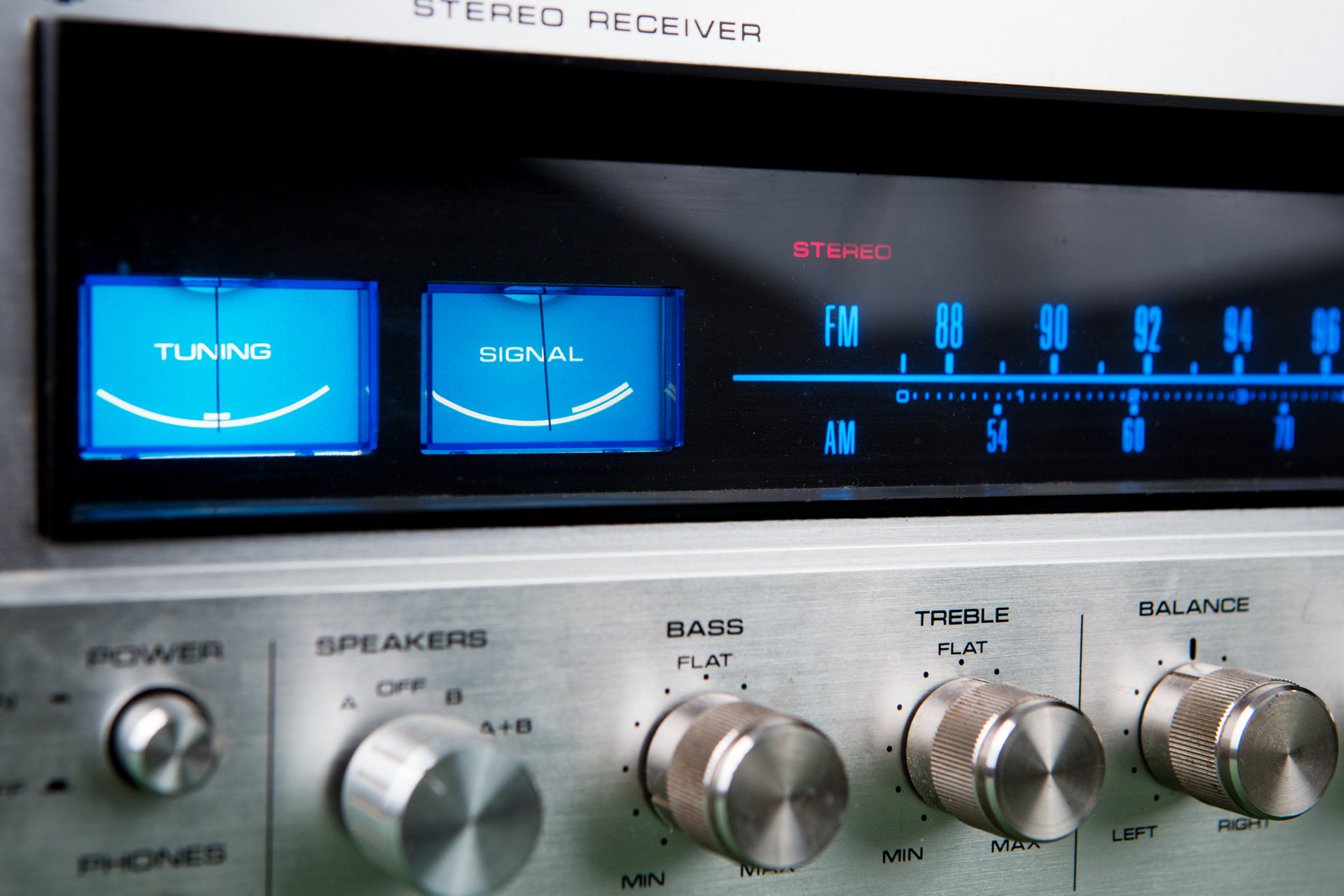If the experience matters (over anything else), might I suggest the Denon AVR-X8500H? Unlike many others on this list, this home theater receiver is the most feature-packed. It covers everything you might need: from Dolby Atmos to HEOS to 8K/60Hz HDMI.
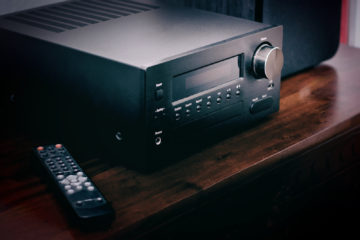
Klipsch reference speakers are some of the most well-known loudspeaker devices revered by audiophiles and casuals. These speakers provide a flat frequency response that allows users to shape the audio quality for a more immersive surround sound experience.
However, for the best audio quality and decoding capabilities, these speakers need a solid AV receiver, and that’s why I’ve made this lineup for the best receiver for Klipsch speakers.
Here I’ve listed a handful of AV receivers, talked about their specs, pros, and cons, and written down a guide to help newbies figure out what an AV receiver is all about. Hopefully, by the end, you’ll have a more solid idea about the best receivers and how to pick them out.
So without further ado, let’s get into our product reviews.
Comparison of the Best Receiver for Klipsch Speakers
| Best Premium Receiver for Klipsch SpeakersSee On Amazon | 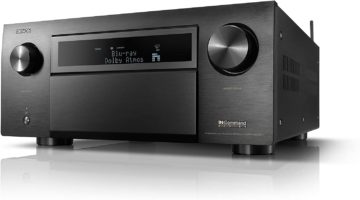 | Denon AVR-X8500H | See On Amazon |
| Best Stereo Reciever for Klipsch Reference SpeakersSee On Amazon | 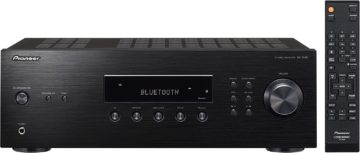 | Pioneer SX-10AE | See On Amazon |
| Best for 7.2 Surround Sound SystemsSee On Amazon | 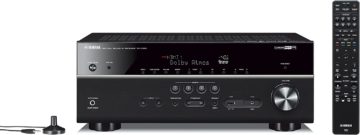 | Yamaha RX-V685 | See On Amazon |
| Best AV Receiver for Dolby AtmosSee On Amazon | 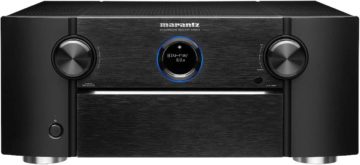 | Marantz SR 8015 | See On Amazon |
| Best Budget-Friendly Receiver for Klipsch SpeakersSee On Amazon | 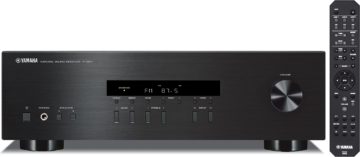 | Yamaha R-S201BL | See On Amazon |
| Best Receiver for Klipsch Speakers OverallSee On Amazon | 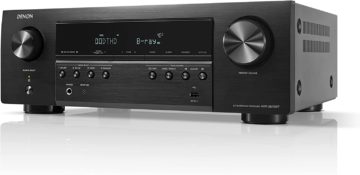 | Denon AVR S570BT | See On Amazon |
Reviews of the Best Receiver for Klipsch Speakers
Specs
- Channels: 13.2
- Dimensions: 17.08 x 18.7 x 7.72 inches
- Weight: 51.6lbs
- Output Power: 150W/channel (@8Ω)
- Connectivity Options: 8/3 HDMI, Bluetooth, Wi-Fi, Ethernet, Alexa
Denon is a giant in the surround sound industry, and their introduction of the Denon AVR-X8500H is a memorable achievement. This AV receiver includes all state-of-the-art features, and it can cater to 13 loudspeaker channels and two subwoofers at once, delivering around 210W per channel at 6Ω impedance. Therefore, it has enough power to drive Klipsch reference speakers with the best sound quality and amplification.
Of course, this receiver also includes the necessary software decoders to complement this. We’ve got Dolby Atmos, DTS:X, and Auro 3D. So for overhead surround sound setups such as 7.1.6 or 9.1.4, the Denon AVR-X8500H is the way to go.
This AV receiver includes eight HDMI inputs with three outputs and supports a maximum 8K resolution at 120Hz with HEOS multiple rooms streaming, Spotify, Airplay 2, Amazon Music HD, and many more.
The Pioneer SX-10AE might not be the most capable receiver out of the ones on this list. But, if you’re looking for a decent stereo receiver with high-end sound quality for your studio monitors or loudspeakers, the Pioneer SX-10AE is a viable alternative.
Specs
- Channels: 2.1
- Dimensions: 12.6″ x 17.1″ x 5.8″
- Weight: 15lbs
- Output Power: 100W/channel (@ 6Ω)
- Connectivity Options: Bluetooth and RCA analog audio only
For those who prefer sound quality over speaker quantity, the Pioneer SX-10AE is the best way to go. It’s an analog-based stereo receiver that takes in RCA and converts/amplifies them into a proper 2.1 surround sound channel (L/R loudspeakers and bass preamp)
This stereo receiver comes with remote control and allows users to manage up to four RCA input sources (CD, Network, Line1, and Line2) along with FM/AM radio and Bluetooth input. You can easily switch between these inputs using the dedicated buttons on the front control.
On top of that, the front panel allows you to control the volume, switch between different presets, control tones, and radio stations, and plug in headphones via a 3.5mm TRS.
The outputs include the 3.5mm port, a direct RCA line out, a subwoofer preamp, and screw terminals for the A and B loudspeakers.
Unfortunately, the lack of digital inputs and HDMI passthrough makes this stereo receiver unfit for a home theater. So you’re better off using these for dedicated music streaming or receiving the RCA signal via your TV. (Which, depending on the decoding capabilities of the TV, defeats the whole purpose.)
The Yamaha RX-V685 is a solid beast. It’s got an extensive I/O layout that supports analog and digital ports, a well-designed interface, and a ton of extra features. It’s another high-value option that I wholeheartedly recommend, especially for a 7.2 surround sound setup.
Specs
- Channels: 7.2
- Dimensions: 14.88″x17.13″x6.73″
- Weight: 23.1lbs
- Output Power Consumption: 90W/channel
- Connectivity Options: 5/2 HDMI, Bluetooth, and Wi-Fi
The Yamaha RX-V685 might not be a flagship AV receiver (with 13.2 channels and whatnot), but it’s chock full of features making it future-proof enough for another decade.
This receiver supports Dolby Atmos, DTS:X, and 7.2 surround sound. On top of that, you can divide the 7.2 surround sound channel into two zones and create a secondary zone to push out stereo audio to music lovers. (All while the primary can function as a 5.2 surround setup.)
Also, the two HDMI outputs allow you to set up an extra television or projector and transmit video and audio to these two devices.
This receiver also integrates Wi-Fi, Bluetooth, Amazon Alexa, and AirPlay, making it easier for the user to stream music online or issue voice commands without using a separate smart device.
Unfortunately, what separates this Yamaha RX-V685 receiver from the high-end models is the lack of 8K passthrough and gaming-related features. As a result, it only allows 4K HDMI video.
The Marantz SR 8015 is not the cheapest AV receiver on the market, but if you want 8K streaming and Dolby Atmos initially set up for your Klipsch speakers and TV, this is the way.
Specs
- Channels: 11.2
- Dimensions: 18.11″ x 17.32″ x 7.48″
- Weight: 34.39lbs
- Output Power Consumption: 140W/channel
- Connectivity Options: 8/3HDMI, Bluetooth, Wi-Fi
Very few receivers can manage to offer up Dolby Atmos in its pure form, and one of these is the widely-known Marantz SR 8015 premium AV receiver.
This receiver’s “Premium” characteristic is not just for the “absurd” price tag. It justifies everything from the audio performance, the I/Os, the controls, and most importantly: the aesthetics.
The receiver looks very stylish and seems to be one of the select few out there who managed to use a hidden front panel with a removable cover. As such, it gives off a minimal look without having to show off the complex display, buttons, and interfaces. (Besides, you won’t be using them anyway since you get a feature-packed remote controller for free.)
The receiver includes everything top-of-the-line for a home theater system. You’ve got 11.2 channels for Dolby Atmos, DTS:X, and Auro 3D with 8K passthrough and upscaling with enhanced technologies to minimize lag and screen tears while gaming.
It’s one of the best receivers for Klipsch speakers and, without a doubt, will take your audio and video experiences to the next level.
Most AV receivers mentioned on this list are premium devices that tend to run in the hundreds, if not thousands, of dollars; hence, it is almost impossible to find an affordable receiver for Klipsch reference speakers. Thankfully, the Yamaha R-S201BL solves this by providing a relatively cheap alternative that’s beautiful, feature-packed, and spits out lossless audio.
Specs
- Channels: Two
- Dimensions: 12.63″ x 17.13″ x 5.5″
- Weight: 14.8lbs
- Output Power: 100W/Channel
- Connectivity Options: RCA
If you’re a simple audiophile, who only wants to enjoy music with your Klipsch speakers, I suggest going for the Yamaha R-S201BL analog receiver. It might be a bit outdated, but it gets the job done and gets it done right.
This analog receiver includes five different RCA input pairs (CD, Record, Playback, and two line inputs) and two pairs of speaker outputs (A and B).
On the front control panel, you’ve got the option to cycle between these inputs.
On top of that, the front control panel allows you to:
- Adjust bass and treble
- Tune the FM/AM radio (and save radio channels)
- Switch between presets
- Plug in headphones
- Adjust the volume output
You can also perform these using the remote controller, which is more intuitive and offers better control over your listening experience.
If you’re looking for a solid mid-ranger with good value for money, the Denon AVR S570BT will not disappoint. It is one of the best AV receivers that open up the capabilities of a 5.2 surround sound entertainment system, whether it’s movies, games, TV, or plain music streaming.
Specs
- Channels: 5.2
- Dimensions: 17.1″ x 13″ x 6″
- Weight: 20.5lbs
- Output Power: 130W/channel (@6Ω)
- Connectivity Options: Bluetooth, 4/1 HDMI (input/output)
The Denon AVR S570BT AV receiver is a solid option for an 8K home theater system. Although the device only supports 5.2 channels, the receiver fares well against other premium alternatives by providing a stable interface with DTS HD Master Audio and Dolby TrueHD decoders.
In terms of the video specs: we’ve got support for the usual formats such as Dolby Vision, HDR10+, Dynamic HDR, etc.. but what impressed me most is the advanced features/technologies such as VRR, QFT, and ALLM, which helps prevent screen tearing and latency during gaming.
So thankfully, this AV receiver won’t detract you from a more immersive sound experience while you’re out exploring the game world.
The receiver supports four 2.1 HDMI ports (designated as Cable, media player, Blu-Ray, Gaming console, and TV) which provide all the above technologies along with 8K resolution at 60Hz framerate (or 4K at 120Hz).
Other noteworthy features include built-in Bluetooth streaming (connected via a smartphone, tablet, or laptop) and compatibility with the Denon AVR remote app. (Along with physical remote control right out of the box.)
Klipsch Speaker Receivers Buying Guide
Channels
How many channels you need for your home theater system or audio setup can be a difficult decision, and if money isn’t a problem, you can go all out on a flagship 13.2-channel receiver.
However, it is not a realistic goal, especially on a tight budget. On top of that, the AV receiver is only half the equation, and you need to factor in the cost of supplementing this AV receiver with enough Klipsch speakers and subwoofers (which could also eat up your budget).
Music lovers tend to go for a stereo receiver that can only handle two full loudspeakers and one subwoofer (see also the best wireless subwoofers). These stereo receivers won’t provide an immersive surround sound experience, and you’re most often limited to analog inputs — often relying on a high-end DAC to maintain audio fidelity.)
That said, gamers and cinephiles would be better off with a 5.2 or 7.2 surround sound setup, as these can handle seven or five full-range speakers with a couple of subwoofers for extra immersion.
Nonetheless, to avoid missing out on the complete experience of surround sound technologies, I recommend a receiver with at “least” seven channels. Seven might be unnecessary for music lovers but would remain a worthwhile investment when you hope to integrate extra speakers in the future.
Build Quality and Durability
Regarding AV receivers, there’s not much you can do about the build quality, especially the internal components.
That said, a few things you need to keep an eye out for is the look and feel of the controls and I/O. If the buttons feel poorly designed, and the speaker terminals and other ports don’t provide a secure connection: it’s not a good sign.
Thankfully, all the AV receivers on our list are from well-known brands, so if you decide to go for those, I can guarantee you won’t run into any problems with the build quality or durability.
Connectivity Options
AV receivers handle both “Audio and Video” because they allow the video signal to pass through while processing the audio for the home theater system or reference speakers. Therefore, considering the connectivity options (especially if you’re going for a fully-fledged entertainment system) is essential.
Apart from the audio channels (which I mentioned in the first part of this guide), it’s better to take note of the number of HDMI inputs and outputs you can get. Typically, you get around five HDMI input devices and a single HDMI output, with a dedicated control knob or buttons to help you cycle through these inputs.
More high-end receivers will include more HDMI ports (usually around eight inputs and three outputs) and offer high-end passthrough for 8K resolution. On top of that, they might provide other technologies that minimize lag (such as variable frame rates, auto low latency mode, etc.)
Price
Let’s face it: AV receivers are not cheap, especially as the number of channels goes up, and as I mentioned, they are only half the picture.
If you’re a beginner, I highly recommend being patient and considering all the equipment you need to complete your setup and then deciding if you can squeeze in the AV receiver of your choice.
Also, you can get a high-end stereo receiver or a 5.2-channel alternative for less than $500.
Conclusion
There are various receiver devices in the market, from analog-only stereo receivers to high-end flagship models that include 8K upscaling HDMI ports and 13.2 channels. There’s a lot of variety, but at the end of the day, it all comes down to how many speakers you utilize in your setup and your use cases (which can be just streaming music to your Klipsch speakers or playing video games, movies, etc.)
Regardless, you will have a much easier time (and hopefully, a new favorite) if you go through my guide and check out the items on this list.
